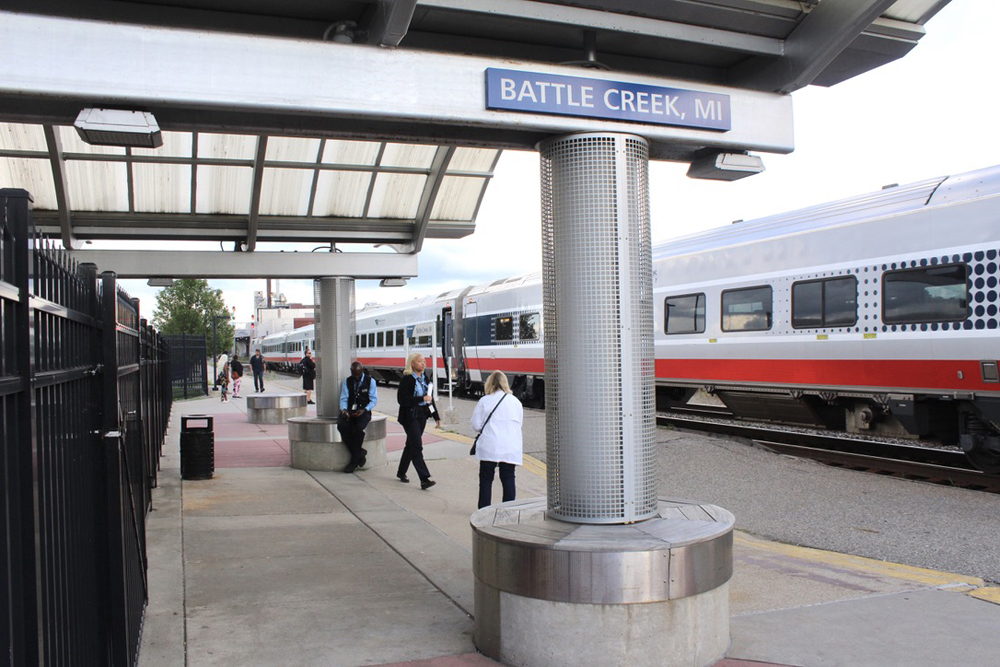
CHICAGO — Upgrading speeds and capacity or simply keeping tracks well-maintained for passenger trains has tradeoffs that often compromise a rail corridor’s ability to provide meaningful mobility while the work is going on.
An example will occur in Michigan beginning May 6, when Amtrak and the state of Michigan jointly made the decision to suspend two Chicago-Pontiac, Mich., trains on the Wolverine corridor Monday through Thursday until Oct. 18.
Amtrak’s service advisory notes that the affected trains, eastbound No. 350, and westbound no. 353 will continue to operate Friday through Sunday, Memorial Day, Labor Day, Juneteenth (June 19) and Independence Day. These are days when maintenance employees either get the day off or work zones move to new locations. Two other Wolverine corridor round trips and the Chicago-Port Huron, Mich., Blue Water, which shares the west end of the corridor as far as Battle Creek, Mich., will “operate normally.”
Schedule alterations and bus substitutions elsewhere
A similar Monday-through-Thursday shutdown for extensive maintenance during daytime hours has occurred during January and February occurrence on Norfolk Southern’s Atlanta-New Orleans segment of Amtrak’s Crescent for more than a decade. A connecting Amtrak Thruway bus at Atlanta is provided on days the train doesn’t run. While not a perfect solution, it preserves the rail option for people who might ride the other direction on an operating day or seek a non-Amtrak option for their entire trip. The alternative would be to do the annual maintenance at night, but this would incur substantial additional costs Amtrak would be expected to pay.
Suspensions with connecting bus alternatives regularly occur on the Boston section of the Lake Shore Limited east of Albany-Rensselaer, N.Y. In Southern California, unstable terrain has forced Pacific Surfliner route closures at San Clemente, Calif., leading to emergency bus substitutions and some cancellations since late January between Los Angeles and San Diego. The current plan, through March 22 and including downloadable schedules, is available on the Surfliner website.
Additionally, two long-distance trains have been temporarily rescheduled to avoid having the trains pass through work zones when tracks are out of service. These include the Sunset Limited through March 24, and the City of New Orleans through April 20.
Illinois disruption solutions
The Joliet-Alton, Ill., portion of Amtrak’s Lincoln Service corridor went through a multi-year convulsion periodically between 2010 and 2018. During this period, deteriorating trackage was replaced with more passing sidings, reconstructed alignments, revamped stations and platforms, and, eventually, a signal system that today permits 110-mph operation across quad gate-equipped highway crossings.
During construction — lengthened by funding shortfalls and technical challenges during the formative phases of positive train control — many trains were routinely cancelled or truncated over a portion of the route. While the Chicago-San Antonio Texas Eagle could be rerouted without stops on Union Pacific’s freight-only former Chicago & Eastern Illinois line, many scheduled Chicago-St. Louis trains turned at Springfield, Ill., or Bloomington-Normal, Ill., to maintain service out of Chicago. Connecting buses often accompanied the rescheduling.
Today’s Michigan challenges
Passengers traveling the Wolverine corridor throughout the last decade have had to endure similar suspensions while tracks were being upgraded. The final puzzle piece, significant curve realignment and bridge replacement triggering the upcoming daytime cancellations, will be taking place around Jackson, Mich., and further east on state-owned track. In conjunction with that shutdown, Amtrak has scheduled a maintenance blitz west of Kalamazoo on its owned segment, which pioneered 110-mph Midwest operation in 2012.
As was the case in 2023, Michigan and Amtrak have opted to maintain daily service outside the daily construction window rather than cancel all trains until all work is completed. This necessarily lengthens the amount of time required to complete all the upgrades.
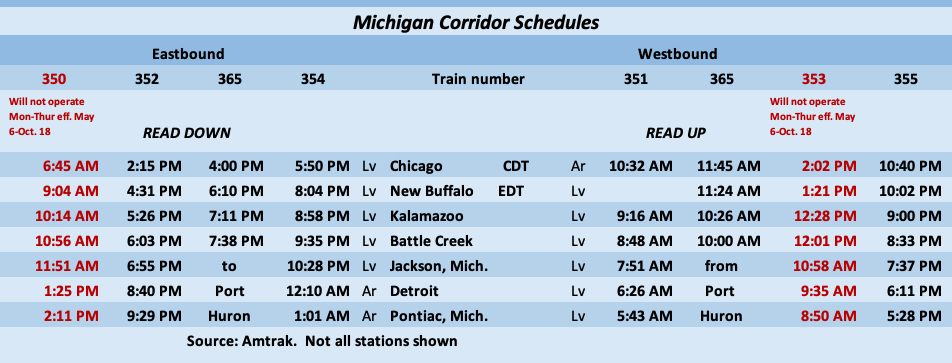
The full schedule with all stops is available from the Rail Passengers Association website.
As projected, cancellation of trains Nos. 350 and 353 creates work periods in the east and west segments between the time westbound trains 351 or 365 and eastbound train 352 pass. However, this means there is a 12-hour gap Monday through Thursday between westbound trains, and only mid-afternoon and evening eastbound departures from Chicago.
Trains News Wire asked the parties if some tactics used elsewhere might mitigate the situation. For instance, eastbound train No. 350 is scheduled to pass both Nos. 351 and 365 en route to Battle Creek, so it theoretically would not interfere with a track closure. The conflict on that western segment is clearly westbound No. 353, but originating it with No. 350’s equipment at Battle Creek back to Chicago four or five hours later than presently scheduled would essentially preserve the work window west of Kalamazoo that closes with train No. 352’s passage. This revamped daytime round trip would only be possible between Chicago and Battle Creek; connecting buses would have to substitute on the eastern portion of the route.
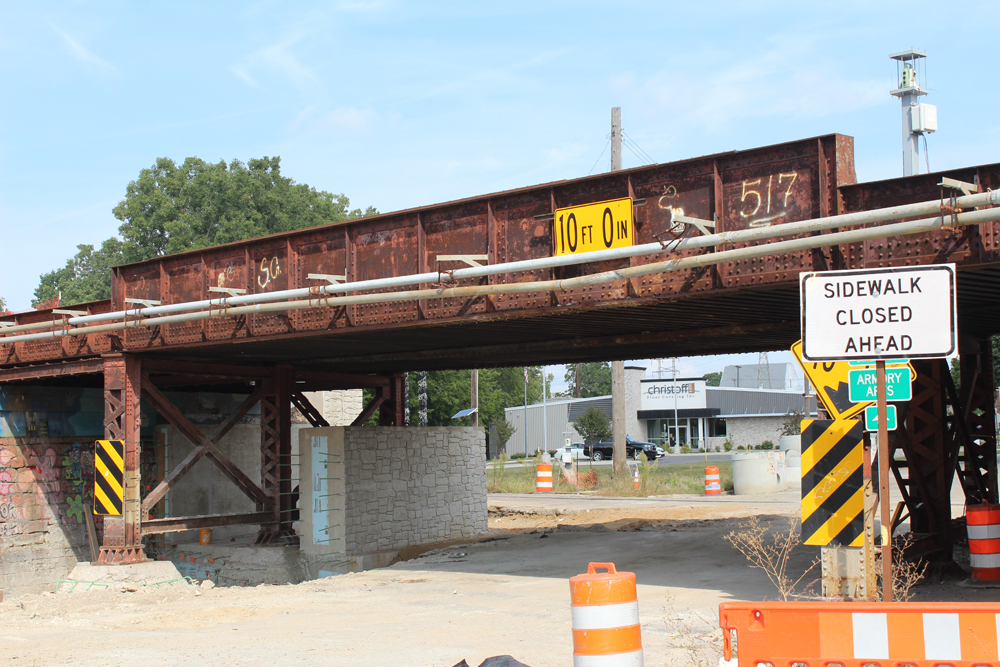
To be sure, there are additional complications. Among them: Norfolk Southern would have to approve a different slot for the rescheduled westbound Michigan train between Porter, Ind., and Chicago, and operating-crew staffing would have to be altered. Having different schedules and a connecting bus service on different days of the week could be confusing, although as noted, this is done for extended periods elsewhere on the Amtrak network.
Responding also on behalf of the Michigan Department of Transportation’s Rail Division, Amtrak spokesman Marc Magliari tells News Wire, “We explored several scenarios, both for last summer and this one. We went with the same plan as last year. … Customers have some tolerance for buses as substitute transportation in an emergency, but not routinely. Also, there is significant cost and confusion that would come from offering a mixed train-bus product, even if only during some lighter days of the week.”
Magliari notes, “We are making the change with a large amount of notice on a corridor with a Blue Water round trip at shared stations in western Michigan.”
Once construction is completed, passengers will have a smoother, faster ride on the Wolverines and Blue Water. But the improvement doesn’t come without some sacrifices.







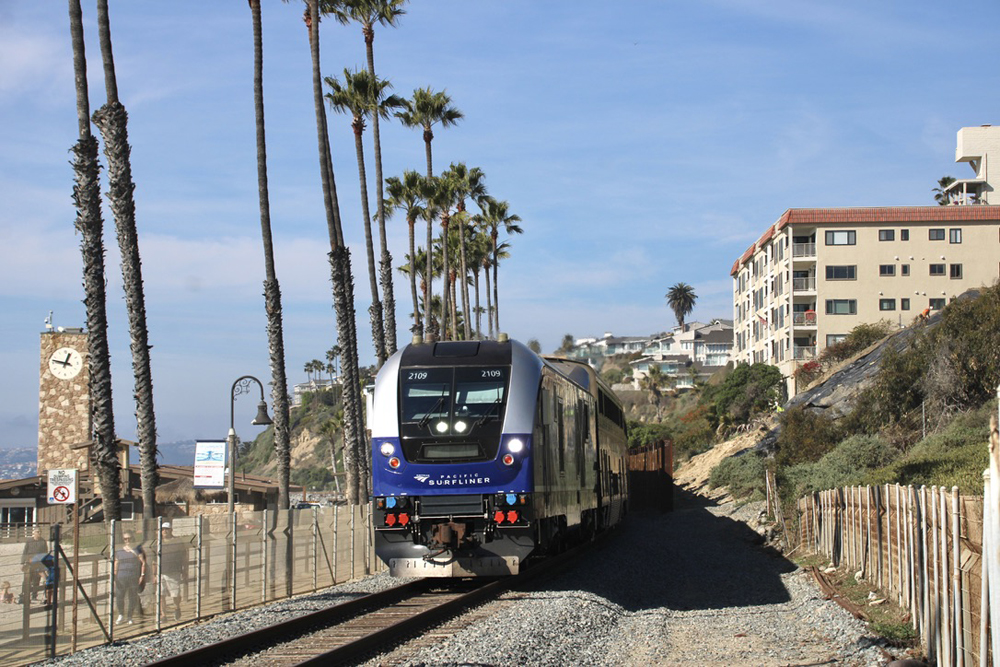
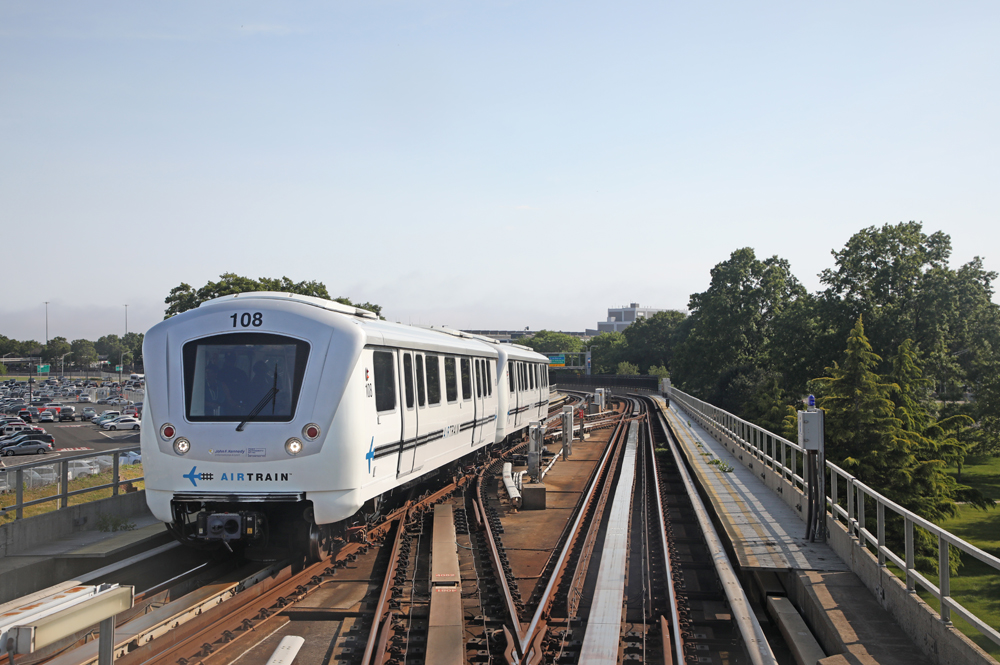





The Crescent takes almost daily delays between Meridian and Atlanta for more than one of each station pairs. The NS work as far as I know is not adding any sidings or connecting sidings to be a 2nd main track, For the proposed new DFW – ATL service that is going to be needed.
Another solution might be for the DFW service travel Meridian – ATL at night and become a day train ATL – NYP. Still that trackwork is going to be needed.
Each city pair needs more track capacity especially BHM- ATL.
Atlanta to New Orleans is a long way. I assume only segments are curfewed for maintainence. Left unsaid is how the freight service is adjusted. The ridership levels between New Orleans and Atlanta must be very low.
Um, Captain Obvious, the Michigan Central used to be double iron. Now it’s single iron.
I get it, every railroad in North America is smarter than I am, so knows the universal benefit of removing the second track. I still don’t. Seems to me, if you go from two tracks to one, it wears out twice as fast. To say nothing of fewer trains moving slower, and having to shut down for maintenance.
Question I’ve never had answered: What is the cost, in diesel fuel, brake shoes, and crew hours, of taking a siding on a single-track railroad.
The Wolverine Corridor has some segments of supposed 110 mph, but overall, Chicago to Ann Arbor, Dearborn, Detroit and Pontiac as a schlep.
Oh, BTW, the photo of the Battle Creek station shows Amtrak running on CNR, the former Grand Trunk Western. I think it was in the 1980’s that the Michigan Central through downtown Battle Creek was abandoned with all trains of both railroads routed over GTW.